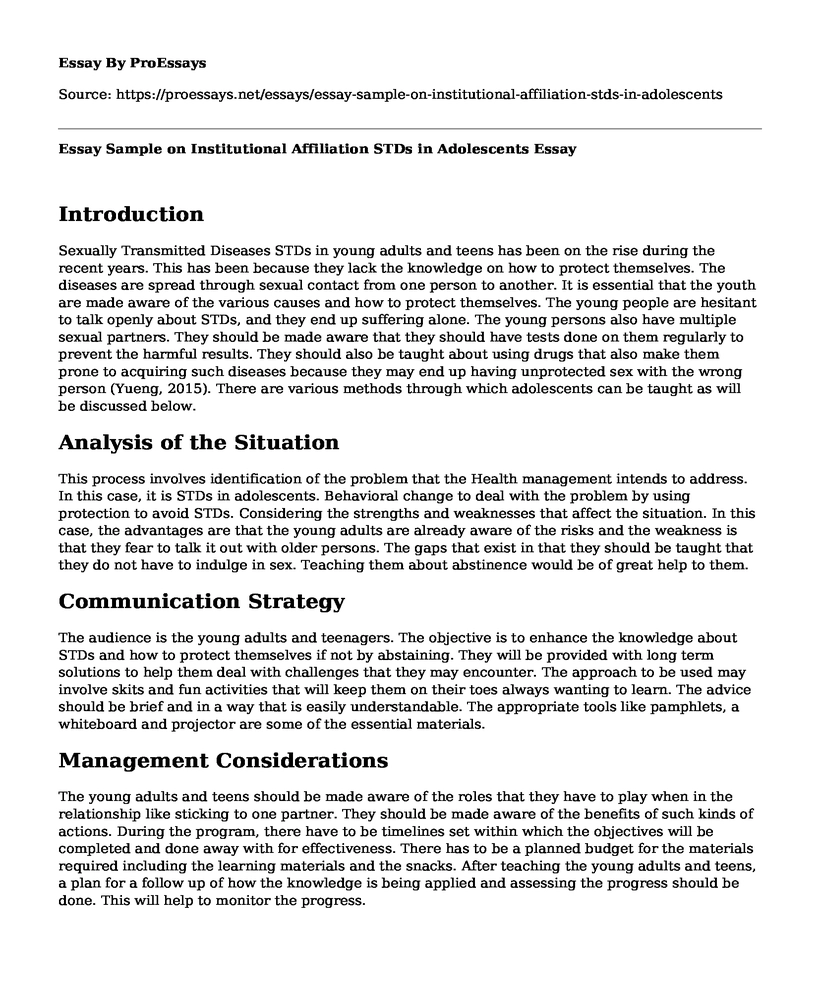Introduction
Sexually Transmitted Diseases STDs in young adults and teens has been on the rise during the recent years. This has been because they lack the knowledge on how to protect themselves. The diseases are spread through sexual contact from one person to another. It is essential that the youth are made aware of the various causes and how to protect themselves. The young people are hesitant to talk openly about STDs, and they end up suffering alone. The young persons also have multiple sexual partners. They should be made aware that they should have tests done on them regularly to prevent the harmful results. They should also be taught about using drugs that also make them prone to acquiring such diseases because they may end up having unprotected sex with the wrong person (Yueng, 2015). There are various methods through which adolescents can be taught as will be discussed below.
Analysis of the Situation
This process involves identification of the problem that the Health management intends to address. In this case, it is STDs in adolescents. Behavioral change to deal with the problem by using protection to avoid STDs. Considering the strengths and weaknesses that affect the situation. In this case, the advantages are that the young adults are already aware of the risks and the weakness is that they fear to talk it out with older persons. The gaps that exist in that they should be taught that they do not have to indulge in sex. Teaching them about abstinence would be of great help to them.
Communication Strategy
The audience is the young adults and teenagers. The objective is to enhance the knowledge about STDs and how to protect themselves if not by abstaining. They will be provided with long term solutions to help them deal with challenges that they may encounter. The approach to be used may involve skits and fun activities that will keep them on their toes always wanting to learn. The advice should be brief and in a way that is easily understandable. The appropriate tools like pamphlets, a whiteboard and projector are some of the essential materials.
Management Considerations
The young adults and teens should be made aware of the roles that they have to play when in the relationship like sticking to one partner. They should be made aware of the benefits of such kinds of actions. During the program, there have to be timelines set within which the objectives will be completed and done away with for effectiveness. There has to be a planned budget for the materials required including the learning materials and the snacks. After teaching the young adults and teens, a plan for a follow up of how the knowledge is being applied and assessing the progress should be done. This will help to monitor the progress.
Evaluation Tracking Progress and Evaluation of Impact
Having completed the planned strategy all that is left is to sit back and wait for the message conveyed to the audience to be applied. Reports from the hospitals and health centers will then be used to know whether the health program was of help to the adolescents. If it is positive, they should continue with the same regularly; if it is average, they should put in more effort to achieve intended results (O'Sullivan et al., 2003).
Conclusion
In conclusion, the high rates of STDs among young adults and adolescents need to be dealt with. Using the proper means to reach out to them and show them the right direction is the key method to be used. Choosing the correct implementation and education strategy to apply will contribute significantly to the results that will be achieved. With the proper levels of mojo to deal with this challenge, it will be easy to attain the intended results within no time especially by healthcare providers and parents too. The role will not be left for persons on one side. It should be emphasized until they can understand the ways to protect themselves from STDs. Until this is achieved, there will be no breaks in the learning programs for them (Mayaud, 2001).
References
Yueng, L., 2015. Sexually Transmitted Diseases: Adolescents and Young Adults. Retrieved on 22nd January 2019 from https://www.cdc.gov
O'Sullivan et al, 2003. A field to designing a Health Communication Strategy. Retrieved on 22nd January 2019 from http://ccp.jhu.edu/documents/A%20Field%20Guide%20to%20Designing%20Health%20Comm%20Strategy.pdf
Mayaud, P., 2001. Interventions against Sexually Transmitted Infections STI to prevent HIV. Retrieved on 22nd January 2019 from https://academic.oup.com/bmb/article
Cite this page
Essay Sample on Institutional Affiliation STDs in Adolescents. (2022, Nov 13). Retrieved from https://proessays.net/essays/essay-sample-on-institutional-affiliation-stds-in-adolescents
If you are the original author of this essay and no longer wish to have it published on the ProEssays website, please click below to request its removal:
- St. John Hospital and Medical Center SWOT Analysis
- Essay Sample: Analysis of the Hospital's Project of Free Children's Cancer Screening
- Argumentative Essay on Organ Transplant and Donation
- Health Factors and Practices in Disaster and Emergency Situations Paper Example
- Vitality Health Enterprises Incorporated Management Accounting Case Study
- Annotated Bibliography Sample on Medication Errors: Understanding and Avoiding Adverse Effects
- Essay Example on Interpersonal Theory: Sullivan







